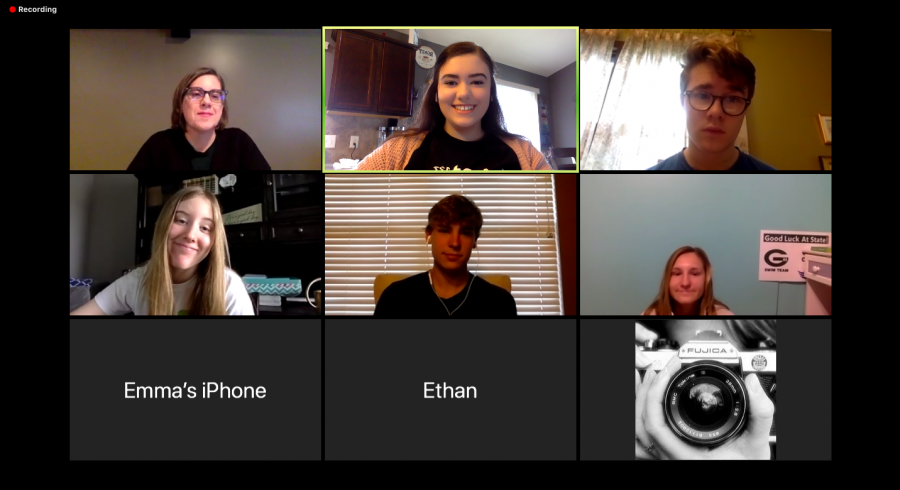Adapting to Distance Learning
District Relies On Technology to Continue Students Education
Still Meeting: Each staff from the journalism department meets once a week via Zoom to discuss their story assignments. They have done this every week since March 23 in order to stay organized and deliver content for their publications.
Along with everything else changing, students and teachers have been forced to adapt to eLearning. One of the main tools schools across the nation are relying on is Zoom Video Communications, a video conferencing app. Teachers are working to make this transition easier using this tool.
“There could be a lot of miscommunication that could happen through just posting something on Google Classroom and hoping students understand,” sophomore Maddy Fauver said. “I think it’s good that we use Zoom because we know for a fact that our teachers are ready to help us if we ever need it. I’m very glad that we have the resources we have and that we are able to use our school computers to keep in touch with our teachers and continue the learning process.”
When the district closed schools, the eLearning plan was put into place. At the high school level, each teacher assigns roughly three assignments for the week on Monday morning, this work is due on Friday.
“We felt getting everything out by Monday morning and due Friday, allowed students to organize their week at their convenience,” assistant principal Mrs. Jami Ewer said. “The tools we chose were easy because most teachers were already using Google Classroom. Every student most likely had at least 1 teacher using it so the transition to get all work that way was easy. Zoom was free and easy to use!”
One of the main challenges presented to teachers is how to deliver their content in a way that will still make sense to students. Teachers are always available to answer emails throughout the day, but it is not the same as face to face communication. While teachers answer emails during school hours, it is still different from face to face communication.
“It’s a matter of making sure that kids get the content that they would know in class because we’re just having them watching videos for most of the math courses,” math instructor Ms. Sarah Benzel said.”It’s not like we can gauge whether they get it or not as we can in person until they take a Google Form. When you’re in class you get instant feedback, you can tell whether they get it or not by their face.”
With math being a subject that many students struggle with, Ms. Benzel and other math instructors have come up with a way to help some students. They do this by using a Zoom feature called breakout rooms, which allows students to be broken up into small groups and work together.
“I do co-teach classes with Mr. Kohles and Mrs. Siemers,” Mrs. Benzel said. “During their classes, we will take those kids and then break them up into thirds and then we will individually work with those handfuls of kids and then we’ll come back together. Then they’re able to get more one on one instruction. We’re able to get better feedback like we would in class on what they understand.”
Another class utilizing Zoom are juniors enrolled in Dual Credit World Civilizations, who join a live lecture via Zoom every Tuesday. Between the two instructors, Mr. David Stastny and Mr. Jon Swanson, over 100 students participate in a call. For students who cannot make it, the lecture is recorded and uploaded for them to watch.
“Obviously we’d rather have students in the classroom, but on Zoom, students can still ask questions, they’re still engaged,” Mr. Stastny said.”It’s the next best thing to being in the classroom. I think that everybody in high school and certainly the staff I’m working with, we’re doing everything we can to still give kids an education. Nobody is giving up, we’re just figuring out how to do the best we can with the circumstances. Between the teachers and the students, everyone is stepping up to the plate.”
Similar to the history department, foreign language teachers are offering Zoom sessions to teach their kids the lesson for the week. By doing this, they are able to make sure students are engaged and are comprehending the material.
“I have Mrs. Ryan for Spanish,” Fauver said. “The first week we just talked, and it was good to talk to my teacher again. The second week she went through and read a couple chapters of our Spanish novel. It was super helpful because if there was a word I didn’t know, she was there to translate it for me.”
Students still have work to do in every class each week, but without a teacher to directly manage them, it can be hard. Not only that, but many miss seeing their friends and teachers every day.
“I really like that we have Zoom as an option because part of what stinks about coronavirus is that I don’t have the social aspect of my life, Fauver said. “Seeing my teachers and friends again is really fun for me.”
A majority of students have access to the technology they need via their school-issued laptops and home wifi networks. However, less than 10 students do not have access to the internet, meaning they do their work on paper packets. The packets are offered for pickup and delivery.
“Without technology, I don’t know how school at home would work,” Mrs. Ewer said. “There would have had to have been some kind of pick up and drop off procedure and A LOT of paper being used. But there would be no way to get teacher help if we didn’t have email or zoom. If we didn’t have technology, school would have just stopped I guess.”
Teachers and students are relying on technology to get through this pandemic and continue their education. The transition to distance learning has not been an easy one, but with all of the resources available, it is working.
]

Kaleigh Zollman is a junior at GHS and is in her third year on The Voice Staff. She serves as the Online Editor for GretnaMedia.com and Copy Editor for...






